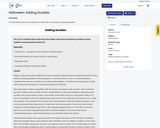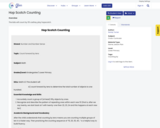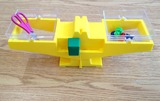
An interactive lesson for students to work with counting and adding doubles.
- Subject:
- Mathematics
- Material Type:
- Lesson
- Author:
- Venessa Davis
- Date Added:
- 08/01/2020

Resources to support the Mathematics Standards of Learning for Lower Primary grades

An interactive lesson for students to work with counting and adding doubles.

The student will be able to count forward to 20 by memory.

Comparing two objects, using direct comparison, according to weight (heavier or lighter).Mathematics Instructional Plans (MIPs) help teachers align instruction with the Mathematics Standards of Learning (SOL) by providing examples of how the knowledge, skills and processes found in the SOL and curriculum framework can be presented to students in the classroom.

Identify and write ordinal numbersMathematics Instructional Plans (MIPs) help teachers align instruction with the Mathematics Standards of Learning (SOL) by providing examples of how the knowledge, skills and processes found in the SOL and curriculum framework can be presented to students in the classroom.

The kids will count by 10's asthey play hopscotch.

Estimating and finding the difference of whole numbersMathematics Instructional Plans (MIPs) help teachers align instruction with the Mathematics Standards of Learning (SOL) by providing examples of how the knowledge, skills and processes found in the SOL and curriculum framework can be presented to students in the classroom.

Comparing two objects, using direct comparison, according to temperature (hotter, colder).Mathematics Instructional Plans (MIPs) help teachers align instruction with the Mathematics Standards of Learning (SOL) by providing examples of how the knowledge, skills and processes found in the SOL and curriculum framework can be presented to students in the classroom.

This resource is a remix from Illustrative Mathematics (https://goopenva.org/courses/3-md-how-heavy). This resource encourages student collaboration and allows students to have a mathematical dialogue as express their understanding of units of measure. Teachers can use objects found around the house to demonstrate mathematics in the real world. I like how this resource adds flexibility in instruction, as it allows teachers to creatively add diverse manipulatives or real-life items on the balance scale. This activity scaffolds the learning process allowing students an opportunity to experience active hands-on learning to strengthen their understanding of mathematical concepts, which provides a diverse learning experience. This resource is a valuable part of building background when introducing units of measure or equations in the early elementary years of mathematics education as it provides students a concrete example of building an equation with concrete objects. Suggested Modification - A student recording sheet with illustrations has been added to the resource to allow all different types of learner to learn from a concrete idea to strengthen conceptual learning about building an equation.

Comparing two objects, using direct comparison, according to length (shorter, longer)Mathematics Instructional Plans (MIPs) help teachers align instruction with the Mathematics Standards of Learning (SOL) by providing examples of how the knowledge, skills and processes found in the SOL and curriculum framework can be presented to students in the classroom.

Lesson plan to use with students in Kindergarten to help them count to 20 and also read and write the numbers.

Comparing two sets using the words more, fewer, and sameMathematics Instructional Plans (MIPs) help teachers align instruction with the Mathematics Standards of Learning (SOL) by providing examples of how the knowledge, skills and processes found in the SOL and curriculum framework can be presented to students in the classroom.

Measurement weight in poundsMathematics Instructional Plans (MIPs) help teachers align instruction with the Mathematics Standards of Learning (SOL) by providing examples of how the knowledge, skills and processes found in the SOL and curriculum framework can be presented to students in the classroom.

Measuring and comparing volume using nonstandard unitsMathematics Instructional Plans (MIPs) help teachers align instruction with the Mathematics Standards of Learning (SOL) by providing examples of how the knowledge, skills and processes found in the SOL and curriculum framework can be presented to students in the classroom.

Set students up for programming success by creating a BeeBot anchor chart!These editable instructions will help students identify their role as planner or driver and set clear expectations of how Bee-Bot is used in computer programming. Tips:Introduce Bee-Bot whole classMake sure students understand the importance of the clear (x) button to erase the previous codealways press clear first to signal a new code (like how a capital letter signals the start of a new sentence) Plan the program in developmentally appropriate steps (some students program one step at a time, while others can program to the end goal)Turn the Bee-Bot off and use it as a game piece to write successful algorithmsHave students write their plan, or algorithm, on a whiteboard instead of using the cardsThe Bee-Bot emulator is perfect for guided practice!

Single step and two-step practical problems involving addition and subtractionMathematics Instructional Plans (MIPs) help teachers align instruction with the Mathematics Standards of Learning (SOL) by providing examples of how the knowledge, skills and processes found in the SOL and curriculum framework can be presented to students in the classroom.

This video is part of the Learn and Grow with WHRO TV series. Watch Dr. Deborah Fuge teach about writing numbers in sequence and out of sequence up to 110.

This video is part of the Learn and Grow with WHRO TV series. Watch Dr. Deborah Fuge teach about solving word problems.

The students are not being efficient when they get materials or move around the classroom, so they are wasting learning time. Students will design a sequence of steps, or program, to move the student to their destination without using extra steps.

This video is part of the Learn and Grow with WHRO TV series. Watch Patty Larson teach about patterns.

1.3 Identifying Ordinal Numbers Co-Teaching MIP